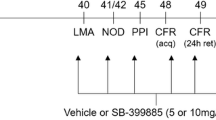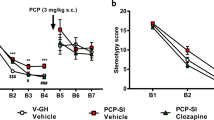Abstract
Rationale
Impaired auditory gating is common in schizophrenic patients. Evidence suggests that this deficit is related to a reduced number of α7 nicotinic receptors and therefore treatment with α7 nicotinic agonists may improve this condition. 3-(2,4)-Dimethoxybenzylidine anabaseine (DMXB; also known as GTS-21) is such an agonist and has shown efficacy in mice both orally and intraperitoneally.
Objective
Rats reared in social isolation post weaning have demonstrated a deficit in auditory gating similar to that seen in schizophrenia patients. The current study determined the effects of DMXB on auditory gating in awake, freely moving rats, comparing a group born and raised in-house and reared in isolation post-weaning (isolation reared) with a group shipped from the supplier as adults and housed in groups prior to surgery (controls).
Methods
Ten unmedicated, baseline recordings were obtained following surgical implantation of a recording electrode. All control group rats and the isolation-reared rats that showed deficient gating at baseline were treated with 1.0, 3.33, 10 or 33 mg/kg DMXB, IP, to determine the drug's impact on auditory gating.
Results
Isolation-reared rats had significantly improved auditory gating at the 3.33, 10 and 33 mg/kg doses, while control rats had a significant impairment in their auditory gating at the 33 mg/kg dose.
Conclusions
DMXB improved the auditory gating deficit seen in isolation-reared rats. As previously observed in another model, the change was produced through a decrease in the test amplitude in isolation-reared animals. Control animals had a significant reduction in conditioning amplitude at the high dose, which produced the loss of auditory gating. The results in the isolation-reared rats are in concert with previous studies which found similar improvement in auditory gating following administration of DMXB to DBA mice, the only differences being in the duration of the effect.




Similar content being viewed by others
References
Adams CE, Stevens KE, Kem WR, Freedman R (2000) Inhibition of nitric oxide synthase prevents α7 nicotinic receptor-mediated restoration of inhibitory auditory gating in rat hippocampus. Brain Res 877:235–244
Adler LE, Pachtman E, Franks R, Pecevich M, Waldo M, Freedman R (1982) Neurophysiological evidence for a defect in neuronal mechanisms involved in sensory gating in schizophrenia. Biol Psychiatry 17:639–654
Adler LE, Rose G, Freedman R (1986) Neurophysiological studies of sensory gating in rats: effects of amphetamine, phencyclidine and haloperidol. Biol Psychiatry 21:787–798
Adler LE, Pang K, Gerhardt G, Rose GM (1988) Modulation of gating of auditory evoked potentials by norepinephrine: Pharmacological evidence obtained using selective neurotoxin. Biol Psychiatry 24:179–190
Adler LE, Hoffer LJ, Griffith J, Waldo MC, Freedman R (1992) Normalization of deficient auditory sensory gating in relatives of schizophrenics by nicotine. Biol Psychiatry 32:607–616
Adler LE, Hoffer LJ, Wiser A, Freedman R (1993) Transient normalization of a defect in auditory sensory processing in schizophrenics following cigarette smoking. Am J Psychiatry 150:1856–1861
Arendash GW, Senstock GJ, Sanberg PR, Kem WR (1995) Improved learning and memory in aged rats with chronic administration of the nicotinic receptor agonist GTS-21. Brain Res 674:252–259
Baker N, Adler LE, Franks RD, Waldo M, Berry S, Nagamoto H, Muckle A, Freedman R (1987) Neurophysiological assessment of gating of sensory input: comparison between schizophrenia and other diagnoses. Biol Psychiatry 22:603–617
Bickford PC, Wear KD (1995) Restoration of sensory gating of auditory evoked response by nicotine in fimbria-fornix lesioned rats. Brain Res 705:235–240
Bickford-Wimer PC, Nagamoto H, Johnson R, Adler LE, Egan M, Rose GM, Freedman R (1990) Auditory sensory gating in hippocampal neurons: a model system in the rat. Biol Psychiatry 27:183–192
Braff DL, Geyer MA (1990) Sensorimotor gating and schizophrenia. Arch Gen Psychiatry 47:181–188
Coates RM, Kem WR, Abbott BC (1971) Isolation and structure of a hoplonemertine toxin. Toxicon 9:15–22
Couturier S, Bertrand D, Matter JM, Hernandez MC, Bertrand S, Miller N, Valera S, Barkas T, Ballivet M (1990) A neuronal nicotinic acetylcholine receptor subunit (α7) is developmentally regulated and forms a homo-oligomeric channel blocked by α-bungarotoxin. Neuron 5:847–856
deFiebre CM, Meyer EM, Henry JC, Muraskin SI, Kem WR, Papke RL (1995) Characterization of a series of anabaseine-derived compounds reveals that the 3-(4)-dimethylaminocinnamylidine derivative is a selective agonist at the neuronal nicotinic α7/125I-α-bungarotoxin receptor subtypes. Mol Pharmacol 47:164–171
Erhardt S, Schwieler L, Engberg G (2002) Excitatory and inhibitory responses of dopamine neurons in the ventral tegmental area to nicotine. Synapse 43:227–237
Freedman R, Adler LE, Bickford PC, Waldo MC, Pachtman E, Franks RD (1983) Neurophysiological evidence for a defect in inhibitory pathways in schizophrenia: comparison of medicated and drug free patients. Biol Psychiatry 18:537–551
Fu Y, Matta SG, Sharp BM (1999) Local alpha-bungarotoxin-sensitive nicotinic receptors modulate hippocampal norepinephrine release by systemic nicotine. J Pharmacol Exp Ther 289:133–139
Gentsch C, Lichtsteiner M, Feer H (1981) Individual housing of rats causes divergent changes in spontaneous and reactive activity. Experientia 37:61–62
Gentsch C, Lichtsteiner M, Kraeuchi K, Feer H (1982) Different reaction patterns in individually and socially-reared rats during exposures to novel environments. Behav Brain Res 4:45–54
Geyer MA, Wilkinson LS, Humby T, Robbins TW (1993) Isolation rearing of rats produces a deficit in prepulse inhibition of acoustic startle similar to that in schizophrenia. Biol Psychiatry 34:361–372
Gilad GM, Mahon BD, Finkelstein Y, Koffler B, Gilad VH (1985) Stress-induced activation of the hippocampal cholinergic system and the pituitary-adrenocortical axis. Brain Res 347:404–408
Grady S, Marks MJ, Wonnacott S, Collins AC (1992) Characterization of nicotinic receptor-mediated [3H]dopamine release from synaptosomes prepared from mouse striatum. J Neurochem 59:848–856
Grady S, Marks MJ, Collins AC (1994) Desensitization of nicotine-stimulated [3H]dopamine release from mouse striatal synaptosomes. J Neurochem 62:1390–1398
Griffith JM, Freedman R (1995) Normalization of the auditory P50 gating deficit of schizophrenic patients after non-REM but not REM sleep. Psychiatry Res 56:271–278
Jones GH, Marsden CA, Robbins TW (1990) Increased sensitivity to amphetamine and reward related stimuli following isolation-rearing in rats: possible disruption of dopamine-dependent mechanisms of the nucleus accumbens. Psychopharmacology 102:364–372
Jones GH, Marsden CA, Robbins TW (1991) Behavioral rigidity and rule-learning following social isolation in rats: Neurochemical correlates. Behav Brain Res 43:35–50
Jones GH, Hernandez TD, Kendall DA, Marsden CA, Robbins TW (1992) Dopaminergic and serotonergic function following isolation rearing in rats: a study of behavioral responses and postmortem and in vivo neurochemistry. Pharmacol Biochem Behav 43:17–35
Kem WR (1971) A study of the occurrence of anabaseine in Paranemertes and other nemertines. Toxicon 9: 23–32
Kem WR (1997) Alzheimer's drug design based upon an invertebrate toxin (anabaseine), which is a potent nicotinic receptor agonist. Invert Neurosci 3:251–259
Kem WR, Mahnir VM, Papke RL, Lingle CJ (1997) Anabaseine is a potent agonist on muscle and neuronal α-bungarotoxin-sensitive nicotinic receptors. J Pharmacol Exp Ther 283:979–992
Luntz-Leybman V, Bickford PC, Freedman R (1992) Cholinergic gating of response to auditory stimuli in rat hippocampus. Brain Res 587:130–136
Mahnir V, Lin B, Prokai-Tatrai K, Kem WR (1998) Pharmacokinetics and urinary excretion of DMXBA (GTS-21), a compound enhancing cognition. Biopharm Drug Dispos 19:147–151
Meyer WM, de Fiebre CM, Hunter BE, Simpkins CE, Frauworth N, de Fiebre NE (1994) Effects of anabaseine-related analogs on rat brain nicotinic receptor binding and on avoidance behaviors. Drug Dev Res 31:127–134
Morgan MJ, Einon D, Morris RGM (1977) Inhibition and isolation rearing in the rat: extinction and satiation. Physiol Behav 18:1–5
Nanri M, Kasahara N, Yamamoto J, Miyake H, Watanabe H (1998) A comparative study on the effects of nicotine and GTS-21, a new nicotinic agonist, on the locomotor activity and brain monoamine level. Jpn J Pharmacol 78:385–389
Papke RL, de Fiebre CM, Kem WR, Meyer EM (1994) The subunit specific effects of novel anabaseine-derived nicotinic agents. In: Giacobini E, Becker R (eds) Alzheimer disease: therapeutic strategies. Birkhauser, Boston, pp 206–211
Pauly JR, Collins AC (1993) An autoradiographic analysis of alterations in nicotinic cholinergic receptors following 1 week of corticosterone supplementation. Neuroendocrinolology 57:262–274
Pauly JR, Ullman EA, Collins AC (1988) Adrenocortical hormone regulation of nicotine sensitivity in mice. Physiol Behav 44:109-116
Pauly JR, Grun EU, Collins AC (1990) Chronic corticosterone administration modulates nicotine sensitivity and brain nicotinic receptor binding in C3H mice. Psychopharmacology 101:310-316
Rollins YS, Stevens KE, Harris KR, Hall ME, Rose GM, Leonard S (1993) Reduction in auditory gating following intracerebroventricular application of α7 antisense oligonucleotides. Soc Neurosci Abstr 19:837
Sahakian BJ, Robbins TW (1977) Isolation rearing enhances tail-pinch induced oral behavior in the rat. Physiol Behav 18:53–58
Simosky JK, Stevens KE, Kem WR, Freedman R (2001) Intragastric DMXB-A, an α7 nicotinic agonist, improves deficient sensory inhibition in DBA/2 mice. Biol Psychiatry 50:493–500
Smith JK, Neill JC, Costall B (1997) Post-weaning housing conditions influence the behavioural effects of cocaine and d-amphetamine. Psychopharmacology 131:23–33
Stevens KE, Bullock AE, Collins AC (2001) Chronic corticosterone treatment alters sensory gating in C3H mice. Pharmacol Biochem Behav 69:359–366
Stevens KE, Freedman R, Collins AC, Hall M, Leonard S, Marks M J, Rose GM (1996) Genetic correlation of hippocampal auditory evoked response and α-bungarotoxin binding in inbred mouse strains. Neuropsychopharmacology 15:152–162
Stevens KE, Fuller LL, Rose GM (1991) Dopaminergic and noradrenergic modulation of amphetamine-induced changes in auditory gating potentials. Brain Res 555:91–98
Stevens KE, Meltzer J, Rose GM (1993) Disruption of sensory gating by the α2 selective noradrenergic antagonist yohimbine. Biol Psychiatry 33:130–132
Stevens KE, Meltzer J, Rose GM (1995) Nicotinic cholinergic normalization of amphetamine-induced loss of auditory gating in freely moving rats. Psychopharmacology 119:163–170
Stevens KE, Johnson RG, Rose GM (1997) Rats reared in social isolation show schizophrenia-like changes in auditory gating. Pharmacol Biochem Behav 58:1031–1036
Stevens KE, Kem WR, Mahnir VM, Freedman R (1998) Selective α7 nicotinic agonists normalize inhibition of auditory response in DBA mice. Psychopharmacology 136:320–327
Stevens KE, Wear KD (1997) Normalizing effects of nicotine and a novel nicotinic agonist on hippocampal auditory gating in two animal models. Pharmacol Biochem Behav 57:869–874
van Haaren F, Anderson KG, Haworth SC, Kem WR (1999) GTS-21, a mixed nicotinic receptor agonist/antagonist, does not affect the nicotine cue. Pharmacol Biochem Behav 64:439–444
Venables P (1964) Input dysfunction in schizophrenia. In: Maher B (ed) Progress in experimental personality research. Academic Press, Orlando, pp 1–47
Venables P (1992) Hippocampal function and schizophrenia: experimental psychological evidence. Ann NY Acad Sci 658:111–127
Wheeler JW, Olubajo O, Storm CB, Duffield RM (1981) Anabaseine: venom alkaloid of Aphaenogaster ants. Science 211:1051–1052
Wilkinson LS, Killcross SS, Humby T, Hall FS, Geyer MA, Robbins TW(1994) Isolation in the rat produces developmentally specific deficits in prepulse inhibition of the acoustic startle response without disrupting latent inhibition. Neuropsychopharmacology 10:61–72
Wilson CL, Babb TL, Halgren E, Wang ML, Crandall PH (1984) Habituation of human limbic neuronal response to sensory stimulation. Exp Neurol 84:74–79
Woodruff-Pak DS, Yong-Tong L, Kem WR (1994) A nicotinic agonist (GTS-21), eyeblink classical conditioning and nicotinic receptor binding in rabbit brain. Brain Res 645:309–317
Zhou FM, Liang Y, Dani JA (2001) Endogenous nicotinic cholinergic activity regulates dopamine release in the striatum. Nature Neurosci 4:1224–1229
Acknowledgements
This study was supported by a VA Merit Award (K.E.S.), and an NIMH USPHS Grant MH58680 (K.E.S.).
Author information
Authors and Affiliations
Corresponding author
Rights and permissions
About this article
Cite this article
O'Neill, H.C., Rieger, K., Kem, W.R. et al. DMXB, an α7 nicotinic agonist, normalizes auditory gating in isolation-reared rats. Psychopharmacology 169, 332–339 (2003). https://doi.org/10.1007/s00213-003-1482-2
Received:
Accepted:
Published:
Issue Date:
DOI: https://doi.org/10.1007/s00213-003-1482-2




